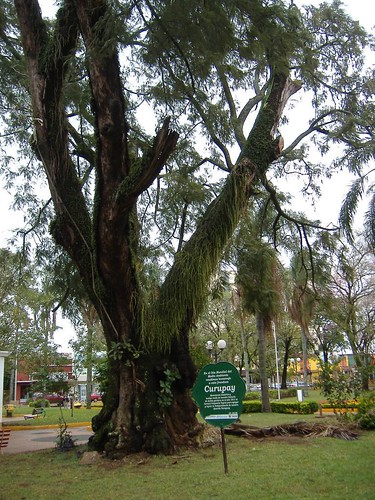The day I went to Encarnación was cold, rainy, dark, and windy. What a pleasure. I had four layers of clothing on. The little bus that takes you there runs through the center of Posadas, so I had to wake up early to catch it. Going through customs is like a punishment. Once you get to the Argentine foot of the Roque González bridge, you have to get off the bus and form a queue before a cramped customs office where half a dozen clerks will get your National Identity Document (DNI), note it down, and return it to you. You exit on the other end of the room, and get on the bus again. The bus hops merrily along the bridge all across the Paraná River, and when you get to the Paraguayan side you have to disembark again, and make a run for the customs office. You hand them your DNI, they check it and give you a piece of paper with a stamp and the DNI number in it. Somebody'll ask for it when you return to Argentina, and if you don't have it they'll charge you 50 pesos, or dollars, according to the variant horror stories told by the passengers. If you don't get your stamped pass quickly, the bus will just move on without you and you'll have to wait for the next one.
Going through customs is like a punishment. Once you get to the Argentine foot of the Roque González bridge, you have to get off the bus and form a queue before a cramped customs office where half a dozen clerks will get your National Identity Document (DNI), note it down, and return it to you. You exit on the other end of the room, and get on the bus again. The bus hops merrily along the bridge all across the Paraná River, and when you get to the Paraguayan side you have to disembark again, and make a run for the customs office. You hand them your DNI, they check it and give you a piece of paper with a stamp and the DNI number in it. Somebody'll ask for it when you return to Argentina, and if you don't have it they'll charge you 50 pesos, or dollars, according to the variant horror stories told by the passengers. If you don't get your stamped pass quickly, the bus will just move on without you and you'll have to wait for the next one.
I caught the bus just in time. I'd been instructed to stay in it as it progressed through the lower (physically and sociologically) neighbourhoods of Encarnación, up to the top. For better or worse, I got off at the bus terminal. I don't have pictures of that part of the city because I was a bit scared of taking out a shiny, if obsolete and cheap, digital camera, and parade around with it taking pictures like the stereotypical stupid tourist. The area around the terminal is full of people trying to get a few coins from you, to sell you watches or pirate DVDs, or to activate the chip on your cell phone for nothing.
Now, before somebody accuses me of being derisive to Paraguay, there are other parts of Encarnación where you won't do business either, and they're no worse than some parts of Rosario, of Buenos Aires, and of every other big Argentine city where I've been. It was the density that threw me off in Encarnación. I walked away a few blocks and I found a wholly different view. The city has a very nice Plaza de Armas, which is the main square, which I assume is called "Arms Plaza" because it was where the army was amassed in times of need, and that's what it was called in colonial times. Encarnación was founded at about the same time as Posadas on the opposite side of the river, in 1615 — it's a very, very old place.

There's a tree in the plaza that testifies to the very age of the settlement. It's called a curupay, which I'm told is Patagonian Rosewood, though I don't see how anything Patagonian can be found growing 1,500 km north of Patagonia. It's only about half the age of the city — just below 200 years.
Encarnación was initially a typical colonial Spanish city, but in the 19th and early 20th centuries it received a lot of immigration from several sources: like Misiones in Argentina, it welcomed a lot of people from central and eastern Europe; and it also encouraged the settlement of Japanese people, something Brazil up north also did (on a massive scale). The traces can be seen readily just by looking around; the last name of the mayor of the city is Schmalko, there are plaques and small monuments thanking the hard-working community of Germans that helped the town grow, and even a bust honouring Ukrainian poet Taras Shevchenko; and at least one employment agency offers jobs in Japan for people of Japanese descent up to the fourth generation.

The Catholic faith has been losing ground to evangelical denominations throughout South America for decades, but in Encarnación there are already well established, traditional non-Catholic Christian churches. From the central European immigrant component, I hoped to see a lot of Lutheran churches (something I saw later in Oberá, Misiones), but I'd neglected the eastern Europeans' faith. It was certainly strange to spot the rounded domes of Orthodox temples in Paraguay. The pictures below are St. George and St. Nicholas:


Another strange sight was the wealth. Not the healthy wealth of a vibrant progressive city (though Encarnación looked quite lively in that respect), but the kind of dubious wealth that shows in an over-abundance of big, shiny, squeakly clean new SUVs and an astonishing proportion of Mercedes rolling in the streets. I swear the bulky Mitsubishis and Toyotas plus the Mercedes made up at least 50% of the vehicles. The same kind of wealth showed even more insidiously in luxurious, mafia-boss-type houses that clashed terribly with their humbler surroundings.

Disregarding that, I liked Encarnación. There aren't many places that look good in such a bad weather. Encarnación has those same deliciously sloping and winding streets as Posadas, those same trees and plants and flowers everywhere, and it must be beautiful if you manage to see it under the sun, even in winter. I had no such opportunity.
One other thing, if you have the chance to visit Paraguay. They have no café culture. This was the most striking change. People in Misiones and in Paraguay talk with the same accent, share a cultural and ethnic background, and manage their affairs similarly, but as soon as you leave Argentina, forget about bars in every corner where you can order and get an espresso coffee just like that. I learned it the hard way — when, just before heading back to Posadas, I craved for a cup of coffee to keep away the cold and lighten myself up a bit, I walked around for half an hour and then I only found a not-so-good-looking bar where I asked for a coffee and after a long while I got... a cup of coffee, as in what you make for your guests at home. No espresso, no small sugar bags, no bubbly water to finish it. Worked alright for me, but only then it hit me I was no longer home.
Our next stop will be San Ignacio and Santa Ana, the missions.














Pablo –
ReplyDeleteHow would you compare Posadas and Encarnación in terms of economic prosperity? Were the people on the bus with you tourists, or do locals cross the border to shop or work? Did you see any monuments to Strössner?
John
Posadas and Encarnación are different kinds of cities. Posadas is a small metropolis (pop. 250K+), and the capital of a province that is not wealthy but industrious and rich. Encarnación is maybe one fourth of Posadas' size and mainly a border town showing marked signs of social inequality.
ReplyDeleteWhen you get into Paraguay, nobody cares. When you get out of Paraguay, you're stopped and your bags are checked by Argentine officials.
I saw very few tourists in Posadas, but the city had a very fine tourist information office. Encarnación has no such thing at all. It has an awesome coast and a history and even nice architecture if you look for it, but no tourist infrastructure.
My impression on the bus is that 90% were Argentinians doing their shopping or getting back from it. (Posadas residents have permanent border passes, so they can skip the Argentine DNI check. The bus only costs 2 pesos. So they may very well cross over every day.) One man even brought a 21" TV set in the bus from Encarnación. I honestly didn't look for cheap articles to buy, except I did notice apparently good shoes at a very good price in a couple of shops.
There were no monuments to Strössner. There were no political graffiti either, that I noticed, and there was nothing regarding the dictatorship. That was another huge difference. I believe Paraguay only recently started thinking of examining its recent history to deal with Strössner's rule.